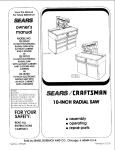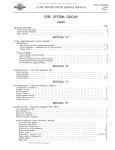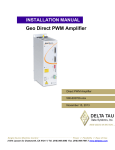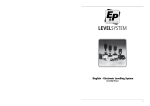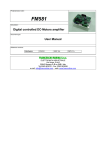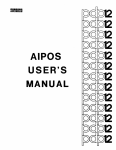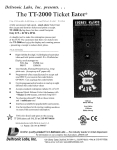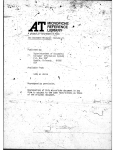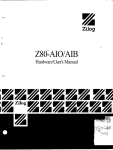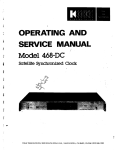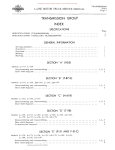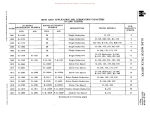Download Propeller Shaft - Hansen Web Design
Transcript
Donated by John & Susan Hansen - For Personal Use Only L-UNE MOTOR TRUCK SERVICE MANUAL PROPELLER SHAFT Index Page 1 PROPELLER SHAFT GROUP INDEX Page GENERAL . . . . . . . . . . . . . . . . . . . • '.' . . . . . . . . . . . . . DISASSEMBLY AND REASSEMBLY OF UNIVERSAL JOINTS Cleaning and inspection . . . . . . . . . . . Lubrication . . . . . . . . . . . . . . . . . . . Type .. c ................ . Type "CC", "CRS" ..... . Type 1410 Spicer . . . . . . . . . . 6 6 1,2 3,4 5.6 CENTER BEARINGS (PRE-LUBRICATED TYPE) Construction • . • . . . Disassembly . . Reassembly . . • . . • • 7 7,8 8 CENTER BEARINGS (NOT PRE-LUBRICATED TYPE) Adjustment • • . . • . . . . . . . . • . . . . . . • . . Construction . . • .' . . . . . . . . . . . . . . . . • . Housing assembly felt seal replacement .. Installation. . . . • . • . . . . .......• Lubrication . . . . . . . Replac ement on shaft . • . 9,10 8,9 10 19 10 10 PROPELLER SHAFT VIBRATION (DRIVE-LINE) Center bearing . • . . . . . • . • . . . • . . Clutch and flywheel • • . . . . . • . • . . . Companion flanges . . . • . • . . • • . . Correct alignment . . . . . • . Engine mountings . . . . . . . • • . . . . . . . Lubrication . • . . . . . . . . . . . . • • . . • . Step-by-step procedure for checking . • • . . . . PRtNT£O IN UNITED STATES OF AMERICA 11 11 11 11 11 11 11,12 Donated by John & Susan Hansen - For Personal Use Only Donated by John & Susan Hansen - For Personal Use Only L-LINE MOTOR TRUCK SERViCE MANUAL PROPELLER SHAFT Section A Page 1 PROPELLER SHAFT PROPELLER SHAFTS AND UNIVERSAL JOINTS The propeller shafts are of tubular construction, having splined slip yokes and universal joints with steel roller bearings. Front propeller shafts have fixed joints while rear propeller shafts have the slip yoke which allows for vari ations in distance between rear axle and trans mission or center bearing. Universal joints used on L-Line trucks are of several types and sizes, and are illustrated below. DRIVE LUG "CS" TYPE TRUNNION BEARING A·raror Fig. 3 -- Showing details of the "cs" type joint. On this type joint the "C" type bear ings are secured by means of straps or lock plates. Fig. I -- Illustration shows details of the "C" type universal joint. with this type joint the four bearings on the journal or cross are al ike. '!.-22.~ff Fig. If -- Spicer propeller shaft joint. "R" TYPE BEARIN Disassembling (Type C) Joint To take a joint and shaft as sern.bly out of a chassis, it is necessary only to remove eight capscrews; the four screws that hold the two bearings to the transmission fitting, whether it be fitting yoke or brake flange fitting, or the center joint fitting on a long wheelbase chassis and the four screws that hold the two bearings to the pinion shaft fitting (Fig. 5). To disengage the bearings from the end fittings, compress the slip joint. Fig. 2 -- Showing details of the NCR" type joint. In this type joint one pair of bear ings is of the "C" type while the opposite pair of bearings is of the OR" type. PRINTED IN UNITED STATES OF AMERICA Care must be taken to prevent the bearings from falling off the journals of the spider when they have been disengaged from the fitting yokes. It is a good idea to tie the bearings together in place on the spider while the other bearings are Donated by John & Susan Hansen - For Personal Use Only PROPELLER SHAFT Section A Page 2 L-UNE MOTOR TRUCK SERVJCE MANUAL Sometimes, due to the air-lock in the bearings not having been entirely eliminated by compressing the bearings, it is necessary to tap the ends of the bearings lightly with a hammer. This will relieve the air-lock and permit the assembly of the bearings to the yoke without further difficulty. Flange type bearing A.22022 Fi g. 5 being disengaged from the slip yoke and pro peller shaft yoke. This precaution should be taken to eliminate the possibility of dirt or other foreign matter from entering the bearings, provided they are to be used iigain. It requires but very little dirt or other foreign matter in a bearing to cause considerable damage to a joint. Unless the propeller shaft or the slip yoke is to be replaced, it is best not to disassemble these two parts. They are balanced in the position in which they are found, and should remain in that position. When a bearing is removed from the spider, the cork packing washer usually comes off with, and remains in, the bearing. If the joint has given considerable service, the cork packing washers should be removed from the bearing and replaced. Reassembling (Type C) Joint All parts should be thoroughly cleaned before they are reassembled. and each bearing should be packed with a small amount of clean lubri cant. (Use a high-grade lightweight semi-fluid chassis lubricant.) Before assembling the bearings to the spider, be sure the four dust shields are in place on the shoulders of the journals of the spider. Place a new cork packing washer on each journal and push it up to the shoulder. Then place the bearing on the journal. Because new cork packing washers are used, and also because a possible air-lock is in the bearings, it is necessary to compress the bear ings in order to get them in the proper location for assembling to the yokes and fittings. After opposite bearings have been compressed as much as possible, a tie wire is to be used to keep them in the compressed position. When all four bearings have been compressed tightly in place on each of the two spiders, these spider and bearing assemblies are then ready for at taching to the propeller shaft yoke and slip yoke. When the key or lug (Fig. l) of a bear ing is seated properly in the keyway of the yoke, the entire face of the bearing will be flat on the face of the yoke. Be sure the entire face of each bearing is flush with the face of the yoke before inserting the capscrews. A single lock plate is used for locking each set of two screws. The screws are to be assembled in the holes of the lock plates before they are inserted in the yoke screw holes. After the screws have been drawn up as tightly as possible, one of the two projecting lips at each end of the lock plate is to be turned up tightly against a flat side of the lock head. It is very important that each screw be securely locked. It is necessary to have perfect alignment of the front and rear joints. Therefore, if either the slip yoke or propeller shaft has been re placed, be sure when assembling these two items that the bearing keyway of the slip yoke is in alignment with the bearing keyway of the pro peller shaft yoke. Due to the design and construction of the drive shaft and universal joint assembly, the replace ment of any part or parts can be accomplished without special tools or garage equipment. Re placements can be made without removing the propeller shaft assembly from the chassis. If a failure occurs in the rear joints, the bearing capscrews can be removed, and the propeller shaft pushed forward in the slip yoke, thereby disengaging the bearings from both the propeller shaft yoke and the pinion shaft yoke. The re assembling of the joint is no more difficult then disassembling. Less difficulty will be ex perienced in the reassembly if the bearings are assembled to the propeller shaft yoke first. The same procedure is to be followed in dis assembling, replacing parts and reassembling the front slip joint, the only difference being that the slip yoke is pushed back on the propeller shaft. The best results will be obtained in the reassembly of this joint if the bearings are first assembled to the slip yoke. If the slip yoke or propeller shaft has been damaged and must be replaced, these two parts can be disassembled merely by removing the slip yoke grease retainer or cap. In such in stances it is necessary to be very careful when reassembling the shaft and slip yoke that the bearing drive lugs of the slip yoke are directly in line with the bearing drive lugs of the pro peller shaft yoke. Arrows stamped on the pro Donated by John & Susan Hansen - For Personal Use Only L-LINE MOTOR TRUCK SERVICE MANUAL Slip yoke PROPELLER SHAFT Section A Page 3 the bearing. The cross IneInber then can be reInoved froIn the yoke without any difficulty. Splined stub Should any of the working parts be worn, they should be renewed with a new cross and four cOInplete bearing asseInblies. In handling these parts, be sure that the trunnions of the cross are clean and that no dirt gets into the bearings be fore they are asseInbled into the joint. It is always advisable to replace the old cork Alignment arrows A·22023 Fig. 6 peller shaft and slip yoke indicate the correct position for asseInbly. THESE ARROWS MUST MATCH (Fig. 6). Disassembling (Type CR, CRS) Joints DisasseInble propeller shaft joint using follow ing procedure: sealing washers on each of the trunnions, which serve to prevent the ingress of dirt and retain the lubricant in the bearing units. Reassembling (Type CR, CRS) Joints Before asseInbling the bearings, be sure that there is lubricant in each one, then proceed as follows: Rest one of the yoke forks on a flat piece of iron, leaving the other fork IneInber freely suspended below, then drive one of the bearings in, so that ReInove the propeller shaft froIn the truck by taking out four capscrews at each end holding the flange type bearings to the fitting yokes, being careful not to let the flanged bearings fall off and perInit foreign Inatter to enter the rollers. ClaInp the propeller shaft in a vise and reInove the flange bearings (two at each end). The reInaining bearings are cylindrical in shape and fit into bore in the yoke arIns. There are snap rings fitting in grooves of the bearings which locate theIn on the inside of the yoke arIns. These snap rings can be reInoved, as shown in Fig. 7, by Ineans of a punch placed against an end of the snap ring loop and then tapping the end of the punch with a haInIner, until the ring COInes off the bearing. After all of the snap rings have been reInoved, the asseInbly can be placed on parallels, or in a vise, as shown in Fig. 8, with the trunnions of the cross resting on parallels on the vise jaws and the yoke IneIn ber s suspended. By striking the suspended yoke, as shown, the yoke IneInber will be driven down until it COInes in contact with the cross. This will leave the bearing protruding, as shown. Fig. 7 After one of the bearings has been driven out in this way, the cOInplete asseInbly should be turned over, and the saIne operation repeated, to drive the opposite bearing out part way. This leaves both bearings protruding frOIn the yoke. The next operation is to claInp the end of a pro truding bearing in a vise, as shown in Fig. 9, and then proceed to strike the yoke IneInber until the bearing is cOInpletely released froIn its snug fit in the yoke. Turn the asseInbly around, claInp the other bearing in the vise in the saIne Inanner as before, and drive yoke IneInber froIn PRINTED IN UNITED STATES or AMERICA Fig. 8 Donated by John & Susan Hansen - For Personal Use Only PROPELLER SHAFT Section A Page 4 L-UNE MOTOR TRUCK SERVICE MANUAL After the first snap ring is in place, the asseInbly should be turned over, as shown in Fig. 12, having the one assembled snap ring at the bottoIn and resting the yoke on the flat iron surface, then striking the bearing on the top, driving the upper bearing down, which carries the lower bearing with it. until the snap ring rests securely against the Inilled surface of the yoke fork. After this is done. put in the opposite snap ring, and the joint is ready for service. Fig. 9 the open end COInes flush with the inside of the yoke fork. Insert the cross through the opposite hole without the bearings, and swing in place and down into the partially assembled bearings. Turn the asseInbly over, resting the above partially assembled bearing on the flat surface, and drive in the other bearing (Fig. 10). Fig. II Fig. 10 By continuing to tap the bearings, they will both find their seats against the ends of the trun nions and will CaIne approxiznately flush with the outside of the yoke. After this is done, it is possible that there will be SaIne off-center condition between the cross and the yoke. This is an advantage, because it permits driving in the snap ring on the side that gives the Inost clearance. This is shown in Fig. 11. Fi g. 12 Donated by John & Susan Hansen - For Personal Use Only L-L1NE "MOTOR TRUCK SERVICE MANUAL PROPELLER SHAFT Section A Page 5 Disassembling (Type 1410 Spicer) Joint a, Remove oil seal retainer from end of slip joint and remove slip joint assembly from shaft, When replacing slip joint, make cer tain that arrows on shaft and joint are in line (Fig. 13). b. Place joint assembly in vise using soft jaws to protect the joint threads, Remove needle bearing assembly from journal or cross (Fig, 14). c. Using a small punch,_ tap end of needle bear ing assembly to loosen snap ring. Move needle bearing only enough to break bearing assembly away from snap ring (Fig, 15). d. Remove snap ring from slip joint or yoke. Turn joint over and remove opposite snap ring ( Fig. 16). Fig. 15 e, Tap needle bearing until opposite needle bearing is free of yoke; using a soft round drift (brass) with flat face about 1/32" small er than the diameter of the hole in the yoke to prevent damage to the bearing (Fig. 17). Fi g. 16 ~.-22718 Fi g. 13 Drift (brass) - -.... Needle _ _- - I I " Bearing Needle Bearing------...,; Fig. I~ PRINTED IN UNITED STATES OF AMUUC" Fig. 17 Donated by John & Susan Hansen - For Personal Use Only PROPELLER SHAFT Section A Page 6 f. g. L-LINE MOTOR TRUCK SERVICE MANUAL Turn yoke or joint over and tap on exposed end of journal or cross end to remove re maining needle bearing (Fig. 18). Remove journal cross from yoke. Tip cross as shown in Fig. 19, and lift out of yoke. Drift - - - - - -...... Cleaning and Inspection 1. CLEAN ALL PARTS--Use a suitable clean ing fluid. Allow the parts to remain in t.he cleaner for some time to loosen up any' particles of grease or foreign matter. Remove any burrs or rough spots from any machined surfaces. 2. NEEDLE BEARING--Do not disassemble. Clean with short stiff brush and blowout with compressed air. Work a small quantity of lubricant (140 S.A.E. Oil) into each needle bearing and turn the needle bearing on the trunnion to check wear. Replace if worn. Journal - - - - -.... 3. JOURNAL CROSS--Because worn needle bearings used with a new journal cross, or new needle bearings used with a worn journal cross, will wear more rapidly (making another replacement necessary in a short time) always replace the journal cross and four needle bearings as a unit. Needle Bearing Fig. 18 Reservoirs Fig. i9 Reassembling (Type 1410 Spicer) Joint Reassembling is merely a reversal of the fore going disassembling operations. On joints with out a lubrication fitting, repack reservoirs in the journal cross ends with a good grade 0 f semi-fluid lubricant (140 S.A.E.). Make sure the reservoirs in each trunnion are filled. With the rollers in the race, fill the race about 1/3 full. Lubrication (Slip Yokes and Joints) Propeller shaft slip yokes are to be lubricated every 3,000 to 5,000 miles. Use viscous chassis lubricant or SAE-140 gear oil. Remove the pipe plug and inject lubricant. Replace the pipe plug. The universal joints are lubricated every 15,000 to 20,000 miles using a viscous lubricant or SAE-140 gear oil. Remove pipe plug and inject lubricant using a low pressure grease gun. Re place pipe plug. 4. JOURNAL AND BEARING KIT--To facilitate the replacement of journals and bearings, a journal and bearing kit is available. The use of the kit insures having the correct individual parts when required, and saves valuable time. Donated by John & Susan Hansen - For Personal Use Only L-UNE MOTOR TRUCK SERVICE MANUAL PROPELLER SHAFT Section A Page 7 PROPELLER SHAFT CENTER BEARINGS A-22499 Fig. 20 -- Pre-lubricated center bearing. Fig. 21 Construction (Pre-Lubricated Type Bearing) The center bearing used on the L-110 to L-150 trucks is the pre-lubricated, single-row ball bearing type. The bearing is permanently sealed against water or dirt entering into bearing to cause rapid wear. The center bearing is still further protected from dirt and water by three slingers and a dust shield, forming an integral part of the center bearing assembly, The flexibility of the mounting protects the bearing from al1 misaligning forces caused by unevenness of the road and results in the lowest possible bearing resistance, a minimum loss of power, and a distinct reduction in drive-line noises, Disassembling (Pre-Lubricated Type Bearing) The prelubricated type center bearing can be serviced without removing the propeller shaft from the truck although a much more satis factory job can be performed by removing the shaft and center bearing assembly from the vehicle. The following illustrations show ser vicing procedure with the shaft removed. Dis assemble the bearing as follows: a. Remove retainer rivets from each side of rear dust shield (Fig. 21). b. Use a broad nose chisel to remove rear dust shield (Fig. 22). c. Remove clamp bolt from rear dust shield assembly (Fig. 23). d, Carefully bend (open) rear dust shield as sembly only enough to remove from the hous ing and shaft (Fig. 24). e, Apply puller to strap or bracket edge of bearing housing, pull housing and bracket assembly from rubber ring (Fig. 25). PRINTEO IN UNITED STArES OF AMERICA Fig. 22 A-22501 Fig. 23 Donated by John & Susan Hansen - For Personal Use Only PROPELLER SHAFT Section A Page 8 L-UNE MOTOR TRUCK SERVICE MANUAL Fig.21t Fig. 25 f. Place puller plates between slinger and rear of bearing and pull bearing with rubber ring and r ear slinger from end of shaft (Fig. 26). NOTE: Make certain that the pulling pressure is exerted on the bearing inner race, or cone, if the bearing is to be reused. The bearing is prelubricated (lubricated at factory) and no further lubri cation is necessary. If the sealing parts (Fig. 27 are damaged during the removal or replacing operation, the bearing is apt to fail because of loss of lubricant. Fig. 26 Fig. 27 Reassembling (Pre-Lubricated Type Bearing) Reassembling procedure is the reverse of the foregoing disassembling operations. Construction (Not Pre-Lubricated Type) Bearing g. Remove rubber from bearing (F . 27). When replacing bearing and rubber ring in housing, apply thin coating of soap solution to ring to permit easy entry of rubber ring into housing. The bearing is a press fit on the shaft. Use a short length of tube or pipe slightly larger on its ID than the propeller shaft spline diameter for pressing on the slinger. bearing and rubber ring as sembly and outer slinger. Figs. 28, 29, and 30 illustrate the construction details of the center bearing assembly as used on L-l60 trucks and up. The center bearing is constructed having a double-row tapered roller bearing operating in a special housing in which lubricant channels have been incorporated to assure a continuous flow of lubricant to the bearing. Donated by John & Susan Hansen - For Personal Use Only L-UNE MOTOR TRUCK SERVICE MANUAL The assembly is amply provided with shields and slingers to prevent the entrance of dirt and water, and the entire assembly is mounted in a rubber ring to provide insulation from the frame. Frame cro88member Rubber ring retainer Tapered roller bearings A-23452 PROPELLER SHAFT Section A Page 9 Installation (Not Pre-Lubricated Type Bearing) Because of accuracy in manufacture, this bear ing has the proper roller contact and specified end clearance. Always install a complete bearing, rather than separate parts. The Service Parts department will supply only the complete bearing. Make a bench assembly of the bearing, housing, and seals, then install this assembly as a unit. Note that the bearing must be a sliding fit in the housing, and that the seals are installed with the rolled edge of the seal to the inside of the housing. Install housing and bearing assembly, having all nuts hand tight. Permit the engine to drive the propeller shaft at a low idle speed to per mit the bearing housing and rubber ring to center themselves in the carrier. Tighten all mounting nuts. Fig. 28 -- Center bearing used on L-160 Series. Adjustment (Not Pre-Lubricated Type Bearing) FRAME CROSSMEMBER Prior to reinstalling a roller bearing of this type, it should be checked for wear or end play. INSULATOR SPACER p:- /~.-J, ~~ Fi g. 29 Series. a. Place the bearing assembly in a vise and mount an indicator as shown in Fig. 31. First, spin the bearing in order to center the races and then immediately check for end play by moving cup toward the indicator as shown. Two or three checks should be made to definitely establish amount of end play present. End play should be from .005" to .008" and corrections should be made if amount is in excess of .008". Center bearing used on L-170, L-180 FRAME / CRDSSMEMBER i Fi g. 31 TAPERED b. Where indicator shows end play to exceed .008", the bearing should be disassembled, thor oughly cleaned, and the c one spacer measured with a micrometer as shown in Fig. 32. c. Reduce the cone spacer thickness the re quired amount (indicator reading less .005 ") through the use of emery cloth on a smooth surface, moving the spacer in a circular motion. See Fig. 33. d. Reassemble bearing and recheck results. See Fig. 34. ROLLER BEARINGS Fig. 30 Series. Center bearing used on L-190, L-200 PRINTED IN UNITED STATES OF AMERICA Donated by John & Susan Hansen - For Personal Use Only PROPELLER SHAFT Section A 10 L-UNE MOTOR TRUCK SERVICE MANUAL Center Bearing Lubrication The lubricant recorrunended for the center bear ing is a medium, short-fibre, wheel bearing grease, the technical specifications of which are a cold-milled sodium-soap type -- not cal cium -- having a work penetration consistency of 250 maximum and which will not work down below 300. The center bearing should be lubricated every 500 to 1000 miles. Center Bearing Replacement on Shaft Motor Truck Service Bulletin No. 25, 1941, de scribes in detail the advisability of testing center bearing installation for interfer,ence between the bearing and the fillet on the pro peller shaft. Interference at this point will cause early failure of the bearing. Center Bearing Housing Assembly Felt Seal Replacement Fi g. 32 When replacing felt seals in the center bearing housing assembly, they should be tested for fit on the propeller shaft as shown in Fig. 35. A break-away tension of from two to eight pounds is considered satisfactory for a dry seal and shaft (not oiled). Fig, 33 Fi g. 3q Fi g. 35 Donated by John & Susan Hansen - For Personal Use Only L-L1NE MOTOR TRUCK SERVICE MANUAL PROPELLER SHAFT Section A Page 11 PROPELLER SHAFT (OR DRIVE LINE) VIDRATION Step-By-Step Procedure For Checking Drive Line Vibration Where drive line vibration is experienced, it will be necessary to inspect the following units as outlined below, before any attempt is made to balance the propeller shafts as described under the heading "Step-by-Step Procedure for Checking Drive Line Vibration". Start engine, and with clutch dis engaged and transmission in gear to keep the clutch disc from spinning, bring engine speed up slowly to governed speed to determine if vibration is in engine itself or due to an out-of-balance clutch pressure plate assembly. If only normal vibra tion is evident, disconnect the front propeller shaft at the transmission companion flange and with transmission in direct drive and clutch engaged, slowly bring engine speed to governed speed to determine if vibration is caused by an out-of-balance clutch disc or out-of-balance transmission gears. COMPANION FLANGES--The companion flange mounting nuts, and the bolts that attach the shaft to the flange, must be tight to assure drive line balance. The least degree of looseness in the flange mounting nuts, or the shaft attaching bolts, is enough to cause excessive (out-of balance) vibration at high propeller shaft speeds. Where the flange also maintains the adjustment on the rear axle pinion bearings or propeller shaft center bearings, this adjustment is de stroyed because of lack of torque on the nut. When a companion flange is removed from a transmission, center bearing or rear axle, the flange and shaft should be marked so that the flange can be reinstalled in the same position on the shaft. Care should be exercised in the removal or replacement of companion flanges as rough handling such as hammering on the trunnion mounting may bend or distort flange. CORRECT ALIGNMENT--Correct alignment of the universal joints is imperative to efficient torque transmission at high speeds. To assure parallel alignment of the universal joints, arrows are stamped on the shaft end and on the slip yoke. These arrows must be lined up; see Fig. 6. If both the above checks show only normal vibra tion, connect the front propeller shaft and use the following step-by-step procedure in balancing the drive line assembly. Drive line vibration can be checked by road test ing truck, spinning the drive line with truck up on jacks or by pulling the rear axle shafts and spinning the drive line. Before any balance weights are added to brake drum or propeller shafts, disconnect the rear pr opeller shaft at center bearing and rotate shaft 180 0 in relation to companion flange (truck without center bearing rotate shaft at trans mission) reconnect shaft then road test truck or spin drive line and check for vibration. LUBRICATION--When a propeller shaft has been removed from a chassis, proper lubrication is an important part in the re-installation opera tion. Be sure to work a small quantity of lubri cant (SAE-140Gear Oil) into the roller assem blies and make certain that the slip joint splines are also properly lubricated. CENTER BEARING--Tighten propeller shaft center bearing mounting bolts. Should the center bearing insulator be deteriorated or oil soaked, it should be replaced. Loose mount ing bolts or an oil soaked or deteriorated in sulator can cause excessive vibration, ENGINE MOUNTINGS--Tighten the engine mount ing bolts. Should the engine mountings be oil soaked or deteriorated, they should be re placed. Loose mounting bolts, or oil soaked or deteriorated mountings, can cause excessive vibration. CLUTCH AND FLYWHEEL--The light side of the flywheel is stamped with a letter "L" and should be lined up with the arrow or inspection mark (usually a white dab or paint) stamped on the heavy side of clutch. (If no arrow is stamped on clutch, it can be assembled to the flywheel in any position.) If these markings are not lined up, excessive vibration can result. PRINTED IN UNITED STATES OF AMERICA Place weight in brake drum flange opposite heavy side of drum Fi g. 36 If vibration is still present after above changes, on truck with brake drum at center bearing, place a lump of glazer's putty weighing approxi mately one-half ounce at brake drum flanges (See Fig. 36). (A small magnet can be used in brake drum flange in place of the putty, liz ounce magnet can be obtained by removing the magnet from a magnetic drain plug), then road Donated by John & Susan Hansen - For Personal Use Only PROPELLER SHAFT Section A Page 12 L-UNE MOTOR TRUCK SERVICE MANUAL te st truck or spin drive line and by changing location of the weight, find the point of least vibration. Then increase or decrease this weight at that point to obtain as nearly as perfect a balance as possible. Weigh the glazer's putty (or magnetic weight) and install a of steel of the same weight in the same location by tack welding weight to inside of brake flange. Hold weld material to a minimum. For truck without a brake drum at the center bearing, use an adjustable hose clamp and a small metal weight (approximately 1/2 ounce). Clamp the weight to the rear shaft near the center bearing and cut off excess material of band as close to clamp as possible (See Fig. 37), Then road test truck or spin drive line; then by moving the weight to various locations on the shaft, find the point of least vibration. Then increase or decrease the weight at this point to obtain as perfect a balance as possible. Mark location of weight on shaft; remove hose clamp and weight. Weigh the weight and add 3/8 of an ounce for clamp screw and nut. Select a piece of steel of this total weight and tack-weld to propeller shaft at locating mark. Hold weld material to a minimum. Cut off excess material of band as close to damp as possible Position weight under hose clamp below clamp screw Place bose damp and weigbt as dose to stub end of shaft as possible A-22905 Fig. 37 For trucks with a single propeller shaft, use an adjustable hose clamp, and a small weight (approximately 1/2 ounce), clamp the weight to the front end of the shaft and cut off excess material of band as close to clamp as possible (See Fig. 37), Then road test the truck or spin the drive line; then by moving the weight to various locations on the shaft, find the point of least vibration. Then increase or decrease the weight at this point to obtain as perfect a balance as possible. Mark location of weight on shaft; remove hose clamp and weight. Weigh the weight and add 3/8 of an ounce for clamp screw and nut. Select a piece of steel of this total weight and tack-weld to propeller shaft at locating mark. Hold weld material to a minimum. CAUTION: When attaching loose weights to propeller shaft with hose clamps (when checking for vibration,) make sure that weights are clamped se curely to shaft to avoid hazard of weights flying off.














